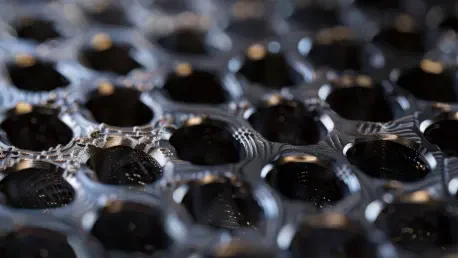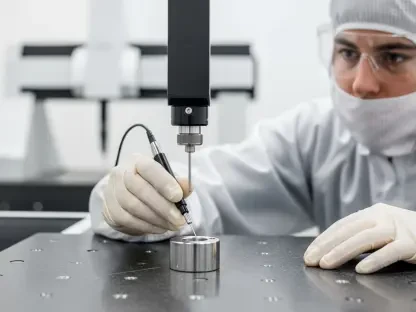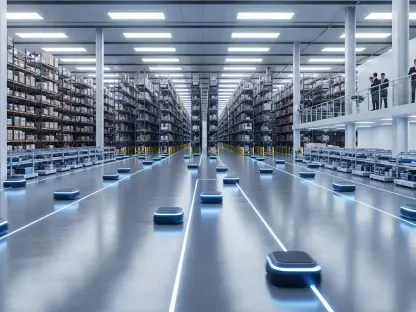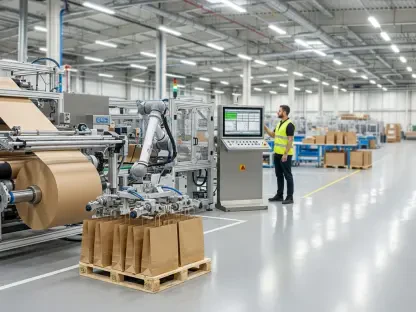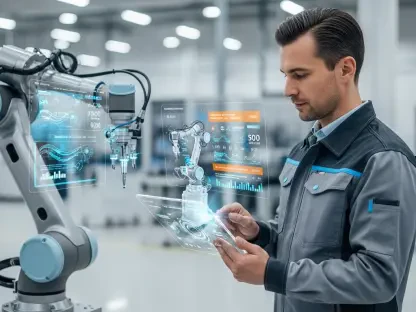Additive manufacturing, particularly with metal powders, is rapidly changing the landscape of North American industries. As technology advances, sectors such as aerospace, medical, and automotive are witnessing significant transformations with numerous benefits and opportunities on the horizon. This revolutionary tech is poised to reshape various industry aspects through increased efficiency, customization, and the potential to meet rigorous safety standards. Understanding the market dynamics, growth prospects, and industry-specific impacts can offer a comprehensive view of how this technology will redefine manufacturing in North America.
The Growth Trajectory
The North American additive manufacturing market with metal powders was valued at USD 220.37 million in 2024. With a projected Compound Annual Growth Rate (CAGR) of 23.12%, it is expected to reach USD 1433.64 million by 2033. This explosive growth indicates the technology’s transformational potential across various industries. Key to this expansion is the increasing adoption of additive manufacturing due to its numerous advantages, including reduced production times, enhanced customizability, and the ability to produce complex geometries that traditional methods struggle to achieve.
As more sectors acknowledge these benefits, the technology’s penetration continues to deepen. Industries are not just adopting it for prototyping but also increasingly for full-scale production, emphasizing its role in streamlining production lines, reducing material waste, and providing significant cost savings over time. The potential for innovation within this market is immense, represented by the vast applications and the scaling capabilities it offers. Hence, the future landscape of North American manufacturing is set on a path of significant transformation driven by metal additive manufacturing.
Aerospace Industry’s Role
The aerospace industry is a significant player driving the market primarily because of its need for lightweight, high-strength components. Metals such as titanium and aluminum are preferred for their ability to reduce aircraft weight while maintaining structural integrity. These materials help increase efficiency, reduce fuel consumption, and ultimately lower operational costs. Increased efficiency and fuel savings are critical metrics in aerospace, where every ounce of weight reduction brings about substantial economic and environmental benefits.
In Boeing’s report, additive manufacturing is highlighted as a crucial factor in reducing lead times for intricate parts. This method not only speeds up production but also ensures that the quality and safety standards, which are highly stringent in aerospace industries, are met efficiently. Products that are lighter yet stronger and can be manufactured faster align well with the Federal Aviation Administration’s safety requirements. As the aerospace sector continues to innovate, the reliance on additive manufacturing techniques is likely to expand, setting new benchmarks in production and operational performance.
Medical Sector Innovations
In the medical sector, additive manufacturing is paving the way for the customization of implants and medical devices. Metals like titanium and stainless steel are integral due to their superior strength and biocompatibility, which are essential for medical implants. This technology enables the creation of patient-specific implants and devices tailored to anatomical requirements, substantially improving treatment outcomes.
With an aging population projected to make up 22% of the U.S. population by 2030, the demand for personalized medical solutions continues to rise. This demographic shift is a primary driver for adopting additive manufacturing in developing custom implants and surgical instruments. The ability to produce medical devices that perfectly fit patients enhances the overall quality of healthcare. Additionally, the speed and precision of additive manufacturing reduce lead times for critical medical supplies, helping address urgent needs and improving patient care effectiveness.
Overcoming Market Restraints
One of the primary barriers to wider adoption of metal additive manufacturing is the high initial investment required for equipment. Industrial-grade 3D printers capable of handling metal powders can cost upwards of $500,000, posing a significant financial hurdle for small and medium enterprises (SMEs). This financial barrier limits accessibility, particularly for smaller companies that could benefit from the technology’s advantages but lack the substantial initial capital needed.
Beyond the initial investment, ancillary costs such as maintenance, software, and skilled labor contribute to the overall expenses, further complicating adoption scenarios. According to Deloitte, only a quarter of SMEs in North America have adopted advanced manufacturing technologies due to these cost concerns. For the market to reach its full potential, strategies to make the technology more accessible and cost-effective for SMEs need to be developed. This includes exploring financing options, subsidies, and partnerships that mitigate initial costs and leverage the technology’s advantages cost-efficiently.
Standardized Materials Shortage
Another challenge facing the market is the limited availability of standardized metal powders. This affects scalability and consistency in production. Variability in powder characteristics can lead to inconsistent outputs, making it difficult for industries to rely on additive manufacturing for large-scale production. The lack of universal certification processes exacerbates this issue, deterring manufacturers who need consistent quality and predictable performance in their production lines.
Manufacturers often have to rely on niche suppliers, which not only raises production costs but also delays projects. Consequently, this dependence hinders broader adoption across various industries. Developing standardized materials and establishing certification processes can significantly improve manufacturing consistency. This would allow for broader adoption and integration of additive manufacturing techniques, ultimately driving down costs and increasing production efficiency across the board.
Opportunities in Renewable Energy
The renewable energy sector presents significant growth potential for additive manufacturing due to the technology’s ability to produce components for wind turbines and solar panels with greater efficiency and cost-effectiveness. For instance, 3D-printed turbine blades made from titanium alloys are 25% lighter and more aerodynamic. These improvements result in higher efficiency and reduced material costs, directly impacting the operational economics of renewable energy projects.
BloombergNEF projects a 40% increase in solar capacity installations in North America by 2030, highlighting the sector’s growth potential. The adoption of additive manufacturing in producing parts for these installations is likely to play a pivotal role, driving the demand for customized, high-performance components that traditional manufacturing methods may struggle to produce efficiently. This transition to renewable energy, coupled with additive manufacturing’s capabilities, could lead to significant advancements in how energy components are designed, manufactured, and deployed, enabling faster and more efficient renewable energy projects.
Automotive Industry Potential
The automotive industry stands to benefit significantly from additive manufacturing, particularly in the production of custom parts and prototypes. McKinsey & Co. reports that additive manufacturing can reduce prototyping costs by up to 50%, accelerating product development cycles. This cost efficiency is crucial in an industry that continually demands innovation and quick turnaround times for new designs and improvements.
Electric vehicles (EVs) are poised to gain significantly from this technology, given the need for intricate battery housings and cooling systems. As the demand for EVs continues to rise, the automotive industry is compelled to innovate rapidly. The precision and customization capabilities of additive manufacturing can help meet these needs efficiently. Advances in additive manufacturing could streamline production processes, improve vehicle performance, and reduce manufacturing costs, enhancing the appeal and accessibility of electric vehicles to a broader consumer base.
Addressing Market Challenges
Despite the promising opportunities that metal additive manufacturing presents, the market faces several challenges such as limited awareness among end-users and significant competition from traditional manufacturing methods. Small and medium enterprises (SMEs) often lack the technical knowledge required to fully understand and leverage the benefits of additive manufacturing beyond prototyping. According to PwC, this lack of technical expertise and training restricts broader adoption, particularly in emerging sectors that could benefit significantly from the technology.
Traditional manufacturing techniques like casting and forging continue to pose strong competition due to perceived cost advantages in high-volume applications such as construction and heavy machinery. These methods, entrenched in the industrial fabric, are seen as more reliable and cost-effective for mass production. The advent of hybrid manufacturing, which combines additive and subtractive processes, further intensifies the competition, making the widespread adoption of metal additive manufacturing a more complex endeavor. Overcoming these challenges will require substantial investment in education, training, and research to highlight the tangible benefits and long-term savings that additive manufacturing can provide.
Technique and Material Segmentation
Powder bed fusion held a dominant market share in 2024, recognized for its precision and minimal material waste. This technique is crucial for applications in aerospace and medical fields where intricate designs and high-quality outputs are paramount. Companies like GE Aviation have successfully utilized powder bed fusion to produce lighter, more efficient fuel nozzles, showcasing the technique’s potential in industrial applications.
Blown powder deposition is another significant technique expected to experience the highest growth, with a projected CAGR of 25.5%. Its ability to repair and coat large components makes it valuable for various industrial applications. Increased funding for research and development supports its growth, underscoring the technique’s adaptability and potential for innovation. Standardization of materials and methods across these techniques will be key to scaling their adoption and ensuring consistent, high-quality outputs in various manufacturing processes.
Material Preferences
Stainless steel has been the leading material segment, owing to its corrosion resistance and durability. Its application in medical and automotive industries cements its dominance in the market. Stainless steel’s versatility and strength make it an essential material in critical components and industrial machinery, where performance and reliability are non-negotiable attributes.
Titanium alloys, however, are expected to emerge as rapidly growing materials with a CAGR of 28.8%. The aerospace sector’s increasing reliance on titanium for its combination of lightweight and high strength attributes drives this growth. Recent advancements in powder production technologies are reducing the costs associated with titanium alloys, making them more accessible for broader industrial applications. This shift in material preferences will likely catalyze more innovative uses and foster increased adoption of additive manufacturing across different sectors.
Summary
Additive manufacturing, especially with metal powders, is swiftly revolutionizing North American industries. As technological advancements continue to progress, key sectors, including aerospace, medical, and automotive, are experiencing substantial change. The advantages of this cutting-edge technology are multifold, promising increased efficiency, enhanced customization, and the possibility of achieving stringent safety standards.
In the aerospace sector, additive manufacturing allows for the creation of lighter, yet stronger components, leading to fuel efficiency and reduced emissions. The medical field benefits from this technology by enabling the production of customized implants and prosthetics tailored to individual patients, thus improving healthcare outcomes. Meanwhile, the automotive industry is seeing faster prototyping and the development of complex parts that would be otherwise impossible or too costly to produce using traditional methods.
Understanding the market dynamics, growth avenues, and the specific impacts on different industries provides deep insights into how additive manufacturing is set to redefine North American manufacturing. This technology’s potential to revolutionize production processes cannot be underestimated, and its influence is bound to grow as further innovations are developed.
